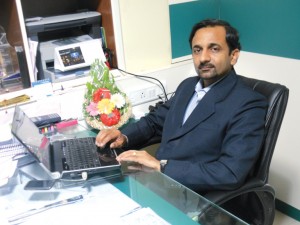 Dr Sandeep Kale, Assistant Professor of Bioprocess Technology, Provides an Informative Account of the World of Biotechnology
Dr Sandeep Kale, Assistant Professor of Bioprocess Technology, Provides an Informative Account of the World of Biotechnology
Best Thing About the Job
I have the freedom to do research work on what I want, to innovate, to commercialize findings for the benefit of society and of course to teach new ideas and advances in biotechnology and bioengineering.
Additional Perks
I have the opportunity to discover new avenues in biotechnology and bioengineering. I also have the satisfaction of creating skilled manpower for industrial development and for the benefit of our country.
Growth Opportunities
In India, the Biotech sector is still a small one, and that’s why in India, opportunities are many. We can initiate many things in this field such as bioenergy from lignocellulosic agricultural wastes, biopesticides, new tools to detect serious diseases like cancer, etc. People can make a career in biotechnology pertaining to environment, agriculture, healthcare, nutraceuticals, diagnostics, renewable energy, marine, etc.
Remuneration
A person with doctorate/post doctoral fellowship in India can expect between Rs. 6 to 15 lakhs per annum; a person with master’s degree can expect Rs. 4 to 7 lakhs per annum, where as a bachelor’s degree holder can expect from Rs. 2 to 4 lakhs per annum. The institute/college has significant role in determining the scale of your salary. A person from IIT, IISc, NIT, IISER, ICT, IMTECH, CCMB, TIFR, NIPER, and universities like Pune University, Anna university, Delhi University, Osmania, etc. are paid relatively higher than other government and private institutes.
Challenges
Research requires a thorough knowledge of the subject, creativity, the ability to think out of the box and bring innovative ideas to innovate a product and/or a process. On the other hand, teaching requires detailed understanding of the subject matter and ability to express is in an effective manner. In both cases, one challenge is common, and that is to improve the quality of life and society.
A Typical Day at Work
For me, a day starts with discussion with my research scholars about the previous day’s outcome and planning the next steps. My day also involves interactions/meetings with personnel from an industry (if any) and teaching the post graduate students. The evening generally goes in scientific writings like patents, journal articles, reports, application notes, etc. The day might look busy, but new things happen almost every day, which provide both joy and satisfaction.
Qualities/Skill Set
One needs to have the ability to understand, innovate, and apply logic and thinking to make something useful through smart work. Also it is important to possess the ability to understand the impact of even the smallest thing. Another important set of qualities is analytical ability, passion, ambition as well as self discipline.
Educational Background
I have a bachelor’s degree in Pharmacy, a Master’s degree in Technology (Bioprocess Technology) and a Doctorate in Chemical Engineering from Institute of Chemical Technology (Formerly UDCT). My diverse background, which includes pharmacy, bioprocess and chemical engineering, really helped me in making better progress both in research and teaching. With this, I am able to do better innovations in biotechnology and allied fields with more than 16 patents (for products, processes and apparatus) and several scientific articles, awards, conference publications and commercialized technologies.
Scope in India
In India, the biotechnology sector is growing, and our country requires skilled manpower to improve the industrial sector. There is big scope in bioenergy (bioalcohols, bio-CNG, biohydrocarbons, etc), secondary agriculture (exploring primary agriculture like grains, oil seeds, fruits, etc for designing various products), getting biorefineries to produce various biochemicals/commodity chemicals (green chemicals) using microbiomes, and of course healthcare biotechnology. We have not yet understood the biological life completely and hence there is scope in both basic biological sciences and its application for development.
Volume 2 Issue 2





























